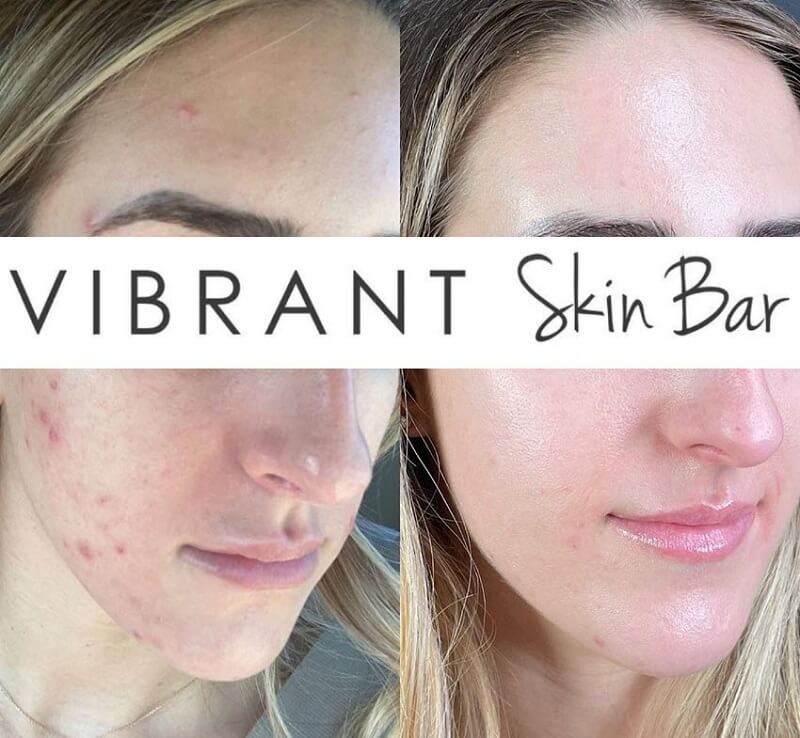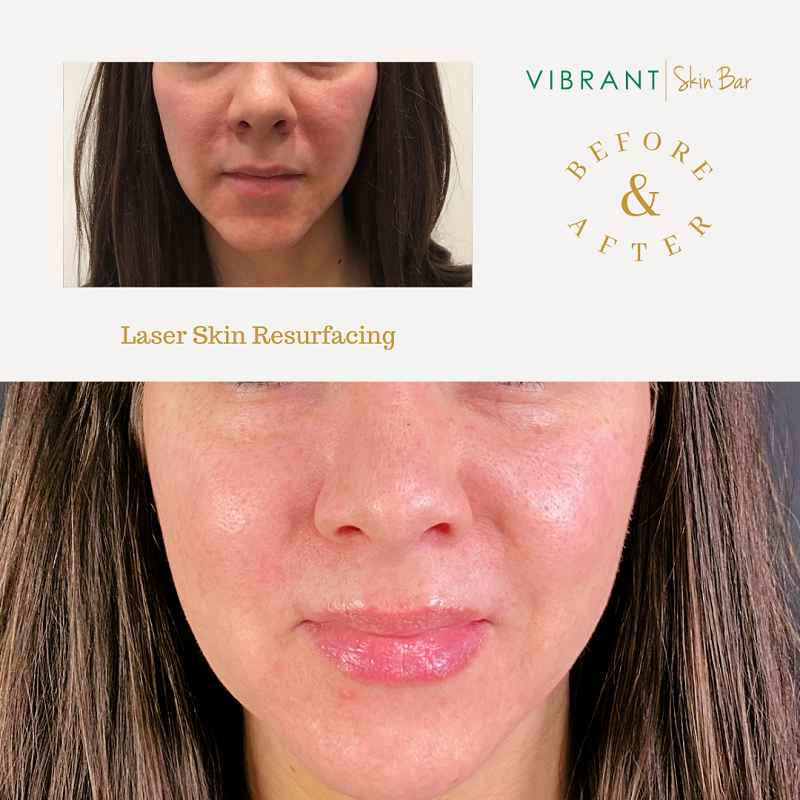From dark spots and wrinkles to spider veins and acne scars, our skin suffers a range of aesthetic and medical issues as we age. Luckily, the cosmetic industry has developed several technologically advanced skin rejuvenation treatments in the past decades. Today, we’ll talk about two of the most popular: microneedling and laser skin resurfacing.
Let’s see how microneedling and laser resurfacing differ and how to determine which procedure is a better option for your skin concerns.

What Is Microneedling?
Microneedling is a minimally invasive cosmetic procedure that involves using an FDA-approved device called a microneedling pen to make tiny punctures on the skin’s surface. The process stimulates collagen production and regenerates the skin.
Note: Learn more about the importance of collagen for the skin and ways to increase its production.
What Is a Laser Treatment?
Laser resurfacing is a cosmetic treatment in which a laser device blasts light energy into the dermis to induce collagen production.
There are two types of laser skin resurfacing:
- Ablative laser resurfacing - This laser therapy removes the surface skin layer and heats the skin. The procedure may require the use of anesthetic or sedatives.
- Non-ablative laser resurfacing - This procedure doesn’t remove outer skin layers and heats dermal layers only. It causes very little pain.
Microneedling vs. Laser: What Are the Differences?
Microneedling and laser therapy have several key differences.
| Microneedling | Laser | |
|---|---|---|
| How it works | A microneedling pen makes tiny puncture wounds on the skin’s surface to induce collagen production as part of the body’s natural healing process. | The laser uses light energy to penetrate the dermal layers and induce collagen production to regenerate the skin. |
| Skin issues it treats | Scarring, uneven skin tone and texture, fine lines and wrinkles, hyperpigmentation, large pores. | Scarring, uneven skin tone, texture, fine lines and wrinkles, hyperpigmentation, skin laxity, spider veins. |
| Downtime | Minimal or no downtime. | Up to one week, depending on the type of laser. |
| Side effects | Common: redness, swelling, tenderness | Common: redness, swelling, itching |
| Treatment duration | 30 minutes | 30-120 minutes |
| Results | Reduced aging signs, tighter skin, even skin tone. Maintenance treatments are required for continued effect. | Reduced aging signs, tighter skin, even skin tone. Maintenance treatments may be needed depending on the skin issue. |
Microneedling vs. Laser: The Ideal Candidate
Both treatments require candidates to be healthy. There is no age limit for these procedures, but medical providers typically perform them on adults. They target various skin concerns, most often premature aging signs. Some skin types and concerns respond better to laser therapy while other benefit more from microneedling.
Microneedling
Men and women who want to reduce wrinkles, age spots, blemishes, scarring, large pores, and improve skin tone and texture may benefit from microneedling.
Laser Therapy
Most healthy people with aesthetic or medical skin issues may undergo laser resurfacing. It is a common treatment for wrinkles, hyperpigmentation, and uneven skin tone and texture. It also helps tighten loose skin and remove spider veins.
Microneedling vs. Laser: The Procedures
Microneedling and laser resurfacing are quick, non-surgical procedures that require minimal or no downtime.
Microneedling
First, the medical provider applies a numbing cream to the patient’s skin. When the skin is numb, the provider moves the microneedling pen over the treatment area in all directions. The device’s tiny needles make minor injuries on the skin’s surface to initiate the body’s natural healing process and boost collagen and elastin production.
After microneedling, the medical provider may apply a serum with growth factors to enhance the effects of the procedure.
A microneedling session takes approximately 30 minutes to complete.
Laser
The medical provider applies a numbing cream or sedates the patient, depending on the laser treatment type.
During ablative laser resurfacing therapy, the laser destroys the epidermis and heats deeper skin layers. The body increases collagen production to repair the wounds caused by the laser.
During non-ablative laser resurfacing treatments, the laser doesn’t wound the surface layer. It only sends heat into the skin.
Both procedures initiate collagen production, but the effects and downtime of non-ablative laser resurfacing are less dramatic.
Microneedling vs. Laser: The Results
The results of microneedling and laser treatments depend on the patient’s skin concern, their age, and how many treatments they undergo. Both treatments visibly rejuvenate the skin,
Microneedling
The increase in collagen production after a microneedling session results in smoother, tighter, and youthful skin. The first results are visible within a few weeks of the procedure, becoming more apparent within three to six months.

Laser Therapy
Laser therapy induces collagen production, resulting in firmer skin and improved skin tone. Ablative lasers provide more dramatic results, while the effects of non-ablative laser therapy are more subtle.

Microneedling vs. Laser: Side Effects
Microneedling and laser resurfacing are considered minimally invasive, but they often cause mild to moderate side effects, as the skin takes time to heal.
Microneedling
It is considered gentler than laser resurfacing, chemical peels, and most other skin rejuvenation treatments.
Common microneedling side effects subside within 24 hours of the procedure, and they include:
- Redness
- Swelling
- Peeling
- Burning
- Dryness
- Tightness
- Discomfort
Laser Therapy
Laser resurfacing side effects are more intense than those of microneedling and take longer to heal. They include:
- Redness
- Swelling
- Itching
- Changes in skin color
More severe side effects, such as infection and scarring, are rare, especially with non-ablative lasers.
Microneedling vs. Laser: Who Should Avoid the Treatments?
During the initial consultation, medical providers emphasize that microneedling and laser therapy are safe for healthy patients. Candidates with certain medical conditions may need to seek other cosmetic solutions.
Microneedling
The procedure is not suitable for people with the following conditions:
- Clotting or bleeding disorders
- High blood sugar
- Taking blood-thinning medications
- Taking acne medication that contains isotretinoin
- Skin infections
- Skin conditions such as eczema and psoriasis
- Hepatitis or HIV
- Auto-immune disease
- Rash or cold sores
- Pregnancy or lactation
Laser Therapy
The procedure is not suitable for people with the following conditions:
- Auto-immune disease
- Proclivity towards scarring
- Taking medication with isotretinoin
- Cold sores
- Herpes
- Pregnancy or lactation
Laser treatments can be riskier for people with darker skin tones because the melanin in their skin absorbs more of the laser’s energy, increasing the chance of burns and pigmentation issues. There are newer types of lasers on the market (such as Nd:YAG lasers), which are safer for darker skin so check with your provider whether laser treatment is suitable for you.
Microneedling vs. Laser: Cost
Cosmetic treatment prices vary depending on the patients’ aesthetic concerns and goals, the med spa location, and the provider’s expertise,
Microneedling
At Vibrant Skin Bar, one microneedling session costs $300. The total cost of the procedure depends on the number of required treatments.
Laser
Our skin experts offer several types of ablative and non-ablative laser treatments.
Halo Pro Laser is a powerful ablative laser and the treatment costs $2,400.
Halo Laser is a fractional laser combining ablative and non-ablative technology, and it costs $1,200 per session.
Laser Photofacial is a non-ablative laser and costs $350 per session.
The total cost of a laser treatment at Vibrant Skin Bar depends on the number of required sessions.
Is Microneedling Better Than Laser?
Microneedling and laser skin resurfacing treat similar skin issues, but the technologies are different. Both have advantages and disadvantages that may help you choose one over the other. For example, laser therapy sometimes doesn’t work for darker skin tones. On the other hand, microneedling doesn’t address spider veins.
Conclusion
Microneedling and laser resurfacing are two of the most popular non-surgical treatments for skin rejuvenation. Sometimes one is better than the other for a specific skin issue, but they generally complement each other.
Choose an experienced, board-certified cosmetic provider who will advise you on the best course of action for your skin.


